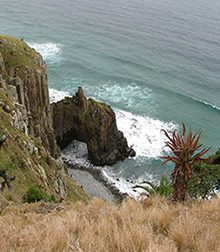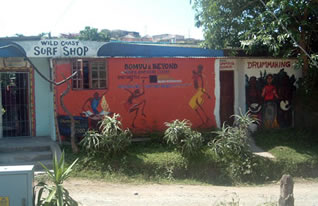The Wild Coast
 In the modern world, ‘wild’ as far as nature is concerned is a relative concept. It is enough, perhaps, that an area of natural beauty is not utterly trampled by urban development, or destroyed by irresponsible land use, for it to deserve the term ‘wild’. Certainly this is the case in the developing world, and most particularly along the earth’s tropical coastlines. The Wild Coast of South Africa’s KwaZulu/Natal, although hardly wild, is by comparison to the KNZ South Coast in a different world altogether. It is a gorgeous natural environment, comprising the signature open grasslands and hill country of the south coast, with deep cut ravines peppered with groves of aloe, and deep tidal estuaries cloaked on either bank with rich and unsullied riparian forest. There is no sign anywhere of mock Tuscan gated developments, of strip malls or the blanket sugar estates so ubiquitous throughout the region. It is moreover an environment fiercely protected by both a large cohort of outside environmentalists and significant numbers of local community members. The latter, almost uniquely, have successfully resisted the temptation to climb into bed with property developers and sell the long term integrity of their landscape for short term profit.
In the modern world, ‘wild’ as far as nature is concerned is a relative concept. It is enough, perhaps, that an area of natural beauty is not utterly trampled by urban development, or destroyed by irresponsible land use, for it to deserve the term ‘wild’. Certainly this is the case in the developing world, and most particularly along the earth’s tropical coastlines. The Wild Coast of South Africa’s KwaZulu/Natal, although hardly wild, is by comparison to the KNZ South Coast in a different world altogether. It is a gorgeous natural environment, comprising the signature open grasslands and hill country of the south coast, with deep cut ravines peppered with groves of aloe, and deep tidal estuaries cloaked on either bank with rich and unsullied riparian forest. There is no sign anywhere of mock Tuscan gated developments, of strip malls or the blanket sugar estates so ubiquitous throughout the region. It is moreover an environment fiercely protected by both a large cohort of outside environmentalists and significant numbers of local community members. The latter, almost uniquely, have successfully resisted the temptation to climb into bed with property developers and sell the long term integrity of their landscape for short term profit.
The Environmental Frontline
Currently, however, the issue is less property development and more highway construction and strip mining. The controversy in the first instances involves the extension of the ubiquitous toll road system, that is the pride of the South African transport infrastructure, through the Transkei, and secondly whether to grant Australian mining conglomerate, Minerals Commodities Limited, and Local Black Economic Empowerment group Xolobeni Empowerment Company, license to dune mine substantial base metal reserves along the coast. While the intricacies of this contest are beyond the scope of this narrative, they do broadly pit local concerns against central and international financial interests. At the core is the question of land ownership, which, in the case of the wild coast, is land owned by the state and held in trust for the people.
With such large amounts of money potentially accruing from a project like this it is understandable that at times community concerns lose focus against the ballast of capital economics and personal greed. What is encouraging about this, however, is the fact that a cognitive debate on the matter is underway at all. This, although a minute precedent in the context of environmental responsibility continent wide, is a step in the right direction. Usually all powerful economic interests, focused typically within a narrow clique of governing plutocrats who tower above the law, have the first and last word in any matter of economic development. This is what sets South Africa apart from much of the rest of Africa, both on a central and a local level, and indeed part of what sets the Wild Coast apart, and a large part of what keeps it wild.
What is the Transkei?
Literally the Transkei is the country north of the Kei River. Politically it is an area once defined as a Bantustan, or a semi-autonomous receptacle for the unwanted blacks of the apartheid economic system, but currently it exists under the South African government after the reintegration of 1994. The demographics of the Transkei (nowadays a classification rather than a political subdivision) still correspond broadly with those defined by the apartheid system, and the region is home to predominantly Xhosa speakers, with a smattering of other groups. It is an overwhelmingly rural and communal society, with the broad social aspect of the territory being one of village homesteads and small community business centers hosting at most a local shop, a school and a bar. The capital of the Transkei is Mthatha, formally Umtata, although the main destination for visitors to the area is Port St John situated on the coast.
From a tourist perspective the Transkei is defined by the Wild Coast itself, and the Wild Coast is defined by some 250 kilometers of unspoilt dune beaches, deep estuaries and rich riparian forests. There are a handful of hotels and back packers lodges scattered up the length of the coast, including the Wild Coast Casino Hotel immediately on the Transkei side of the Umtanvuna River, but others less overtly themed, and a handful of excellent community run tourist projects that transport one back to the intimacy of life on the brink of nature.
What is On Offer?
As is the case with anywhere in SA, there is no one attraction on the Wild Coast, and no one place to stay, nor one single organization to help you facilitate your activities. Apart from the natural gifts of the landscape itself, and the soft texture of village life preserved upon it, Transkei has laid claim to the unique pedigree of being the home of Nelson Mandela. There are many institutions, places and organizations that claim a small piece of the great man’s legacy, but without doubt this, the Xhosa heartland, is where the multi-faceted life of Mandela indeed began. The Nelson Mandela Route, an historical tour of the region, provides a basic framework not only to glance at the origins of The Struggle, but also at the more general history of a very interesting historical destination.
From an ecological perspective there are a handful of nature reserves, all more or less focused on the coast, and offering a variety of scenery from the signature rugged coastline and sweeping sand beaches to preserved stands of indigenous forest and the floral diversity of the grasslands. This range of local habitats lends the area perfectly to those interested in bird watching, for, apart from the astonishing multiplicity of color and life to be expected in the dense riparian forests, the grasslands and the coast are equally rich in variety.
Hiking and horse trails are a very popular way to get to the grass roots and experience the Wild Coast. There are a number of commercial options, quite a few operated on a community basis, and all offering variations on the same basic theme. It is important to bear in mind, however, that although unassisted hikes are permitted, they very inadvisable in the light of the crime situation in South Africa. Along the length of the coast there are a number of separate and defined trail options highlighting particular features of the coast.
The Wild Coast is, as indeed is the entire South Coast, an excellent angling destination. Both surf and ski boat options are available, but again, as an outsider, avoid any solo expeditions unassisted by a local.
For drivers exploring the coastal tracks and byways, exercise caution both in terms of the avoidance of crime, and the avoidance of an African speed trap which usually takes the form of a large bovine animal ruminating in the middle of the road. Remain alert at all times, and avoid any obviously risky situations.
 Accommodation & Adventure
Accommodation & Adventure
Hotels, lodges and backpackers lodges abound. For a compressive listing of these visit www.wildcoast.co.za, or pick up a Coast to Coast guide at any lodge or hotel in the neighborhood. An interesting, and perhaps even essential option, is the handful of community run camps and lodges scattered along the length of the coast. The best intro into this is via Amadiba Adventures, situated at the Mzamba Craft Center immediately opposite the entrance to the Wild Coast Sun Casino Hotel. You can’t miss it. Besides supporting community eco projects, you will also get an authentic vibe that is usually only canned and showcased by more commercial operators.
An excellent intro into the variety of adventure options in the locality, from surfing to gorge jumping, is via the backpacker lodge network that in South Africa is probably the most finely tuned in the world. Even if backpacking is not your style, the most up to the minute info is always available around the bar of your local backpackers lodge, so a visit is always worthwhile.
A last Thought.
The Wild Coast is a little jewel in an economy of voracious coastal development. While you enjoy it, remember that many noble people have, and continue to, dedicate their lives to protecting it. It is a unique phenomenon, so where ever you put your money when you visit, try and make sure it is in the pockets of someone or something that has the best interest of the area at heart. Not all whites involved are trying to develop the beach front for profit, and not all the blacks are trying to protect their traditional heritage. There are as many hungry eyes on on the area from both sides of the race spectrum, and as many villains as there are eco-warriors fighting for the future. Stake your claim, and be part of the preservation.